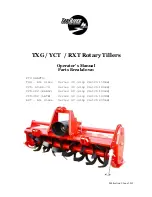
26
SECTION II: INSTALLATION AND MAINTENANCE
II.11
SCHEMATIC TROUBLESHOOTING
Lack of voltage to the pump unit:
check the electrical connections and auxiliary fuses.
No signal from the control board:
check, request authorised assistance.
Pump blocked:
check and clear as necessary.
Faulty pump motor:
repair or replace the pump.
Faulty pump speed switch:
repair or replace the component.
Work set-point is reached:
check.
Microprocessor board alarm:
identify the alarm.
No voltage; manoeuvre isolator switch open:
close isolator.
Tripped compressor thermal protection:
check the electrical circuits and the motor windings and identify any short
circuits; check for an overload in the mains and any loose connections.
Tripped overload fuses:
reset the fuses and check the unit at start-up.
No request for cooling with working set point correct:
check and if necessary, wait for the cooling request.
Work set-point too high:
check setting and reset.
Defective contactors:
replace or repair.
Compressor electric motor failure:
check for a short circuit.
Incorrect power supply voltage
check voltage, investigate causes.
Faulty compressor contactors:
replace.
Mechanical problems in the compressor:
repair compressor.
Faulty low pressure switch:
check the calibration and functions.
Insufficient refrigerant:
top-up the correct amount, identify and eliminate any leaks.
Blocked gas line filter (appears frosted):
replace.
Irregular operation of the expansion valve:
verify its correct operation and if necessary, replace.
Malfunctioning high pressure switch:
check the calibration and functions.
Insufficient cooling air to the coils:
check fans, check clearances around unit and possible coil obstructions.
High ambient temperature:
check unit operation limits.
Refrigerant charge excessive:
drain the excess.
The compressor is pumping liquid; excessive refrigerant fluid in
crankcase:
verify whether the expansion valve works correctly and if necessary,
replace it.
Mechanical problems in the compressor:
repair compressor.
Unit running at the limit of the specified conditions of use:
verify compliance with the stipulated limits.
Excessive thermal load:
verify the system size, leaks and insulation.
Work set-point too low:
check setting and reset.
Poor ventilation in the coils:
check fans, check clearances around unit and possible coil obstructions.
Insufficient refrigerant:
top-up the correct amount, identify and eliminate any leaks.
Blocked filter (appears frosted):
replace.
Control board faulty:
replace the board and verify.
Irregular operation of the expansion valve:
replace.
Irregular contactor operation:
verify the functions.
Work set-point too high:
check setting and reset.
Insufficient water flow:
check and adjust as necessary.
Refrigerant leakage:
verify, identify and eliminate the leak; top-up the correct amount of
refrigerant and oil.
Crankcase resistance interrupted:
verify and replace, if necessary.
Unit running is anomalous conditions:
verify the unit sizing.
1 - THE CIRCULATION PUMP DOES NOT START (IF CONNECTED):
6 - EXCESSIVE COMPRESSOR NOISE - EXCESSIVE VIBRATIONS
Problem:
Recommended action:
2 - THE COMPRESSOR DOES NOT START:
3 - THE COMPRESSOR DOES NOT START - A BUZZING SOUND IS HEARD:
4 - THE COMPRESSOR WORKS INTERMITTENTLY:
5 - THE COMPRESSOR STOPS:
7 - THE COMPRESSOR RUNS CONTINUOUSLY
8 - THE COMPRESSOR PARTIALISES CONTINUOUSLY
9 - LOW OIL LEVEL
Summary of Contents for EQU-PF 2100
Page 60: ...NOTE...
















































